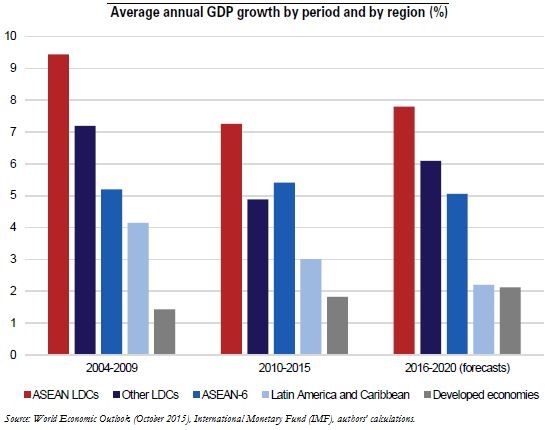Trésor-Economics No. 173 - What are the prospects of economic catch-up for the least developed countries of Southeast Asia?
Only eight of the 48 least developed countries (LDCs) listed by the United Nations are located in Asia. This sets them apart among both Asian countries and LDCs. Three–Myanmar, Cambodia and Lao–are located in the Greater Mekong Subregion (GMR) of Southeast Asia. The World Bank includes them among its "Olympians of growth"-countries with some of the highest growth rates over the past 20 years.
Are the ASEAN LDCs like other LDCs? The question can be answered by considering what is specific to their growth paths, identifying their drivers and assessing their development prospects. A comparative analysis shows that they are better poised than the other LDCs to graduate from the UN category, while remaining pre-emerging economies (see chart below). In addition to strong economic growth and the quality of their human capital, what sets them apart from their peers is their geographical location in a region that is a global magnet for foreign direct investment (FDI) and, in addition, shares a border with China.
The ASEAN LDCs exhibit a persistent gap with Vietnam, the pre-emerging reference economy for this study, which attracted 7% of inward FDI to Southeast Asia in 2014 versus 2.5% for the three LDCs combined. This gap is mainly attributable to a different form of international insertion. The ASEAN LDCs are still rural economies specialised in low value-added products-the textile industry for Cambodia, and raw materials for Lao and Myanmar-and they have few trading partners. By contrast, Vietnam's economy has diversified, reducing its dependence on raw materials exports while developing a competitive industrial offering.
The economic and financial interdependence of ASEAN LDCs with China has intensified over the past decade. Trade has virtually quadrupled since 2010, and has grown 18-fold since 2000. The combined stock of Chinese investment in the three LDCs approached $12bn in 2014, or three times the level of 2010, and 150 times the level of 2003. China has thus become a vital source of external financing.
Myanmar, Cambodia and Lao are therefore on the front line of Chinese economic expansion in Southeast Asia. They also border two regional economic powers: Thailand and Vietnam. This proximity does not mean, however, that their catch-up with the club of Asian Tigers would require the same degree of industrialisation and internationalisation. The countries in the GMR must leverage their comparative advantages.
